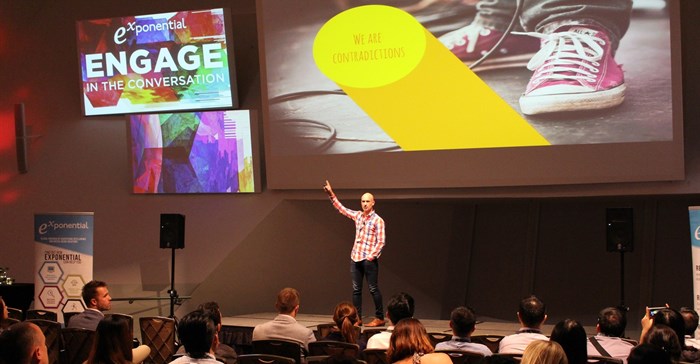Use data to constantly innovate
Greer says there are a number of commonalities between people and data, which are both in abundance at the moment – both need to be housed, kept secure and put to meaningful work, and each helps us understand the other. He explains, “The big similarity between people and data is that one should be able to help us understand the other. Data, when collected the right way and interpreted correctly, should be able to help us understand people. And people, through insight and experience, should be able to help us understand data. Relying on one without the other is denying the benefits of both.”

So, while it’s fair and well having access to big data, do you know how to successfully separate the useful insights from the junk? If not, you’re wasting your time. Without actionable data, you can’t really put all that information to use by cleverly building campaign strategies around it – putting the data to work for you, as opposed to seeing it as a snowballing obstacle to sift through or worse, avoid by storing it in ‘File 13’.
Now’s the time to buckle down and make headway, as each year we’re collecting more data than all the years of human history that came before it. Greer talks us through how to successfully do so by focusing on quality over quantity.
1. Explain how too much data can be overwhelming to some businesses.
Greer: Too much data is like too much of anything: it makes it difficult to sort out the good and useful from the poor and useless. For the past few years the goal for companies has often been around the methods of data collection and the scale that can be accumulated, rather than ensuring that what is being brought in is of the best quality.
This year we have collected more data on humans than we have in the entire 10,000 years of human civilisation that preceded it. There’s simply no way that all of this is of value. Companies firstly need to determine the types of data they need to collect to succeed in their appointed areas and, secondly, have the people and tools in place to uncover the nuggets and insights they haven’t planned for but might be of value.
2. That links to the benefits of data – as a critical part of planning and marketing, how can businesses properly employ the data already at their fingertips to improve business functioning?
Greer: Much of this is about structure within organisations. So often I have heard from marketers that their company has a fantastic group of data analysts collecting amazing information and insight… and they never, ever speak to them. Data is only of value if it is used to improve company output, and this means building structures that can absorb and act on this information.
It’s also important for businesses to clearly understand the point of collecting data, and how it might improve various parts of their business processes. Is it to understand their existing customers, or how to reach new ones? Is it to create better distribution channels? How technology can improve their customer experience? What external stressors might impact business? It could be anything, but it’s hard to find something if you don’t know what it is you’re seeking.
3. Especially as we’ve become ‘hyperconsumers’ of content. Explain the implications of this on advertising, branding and retail, especially with regard to the death of demographic marketing…
Greer: This is really about access – to ideas, information, trends, health, fashion, everything, and how it intersects with the overall disintegration of strict generational segments. Marketers have successfully allowed access points to most products for anyone who can afford it. From clothes to tech to yoga mats and beverages, classing people by their consumption habits is a lot more accurate than by other demographic factors like age or income or gender.
But brands need to acknowledge that their consumer base is unlikely to be ring-fenced within simple demographic profiles. That is not always true, but is increasingly the case. Fortunately, behaviour data can help us understand the sorts of things that propel people into market. We can see, through things like tracking online behaviour, when people are moving into market for products and, more importantly, why.
Exponential believes that what people do online tells us who they are offline. You only have to [take off your marketer hat and] consider your own behaviour when planning a purchase and how you use the internet to gather information – these are breadcrumbs, leaving a trail of data that can be gathered and understood by brands.
4. Makes sense. How can businesses then move away from purely focusing on gathering as much Big Data as possible to that all-important actionable, insights-driven data?
Greer: Businesses need not jettison their connection with Big Data, but they do need to ask themselves a few important questions: Where does it come from? How is it collected? How old is it? What is my goal in collecting and interpreting it? There is nothing inherently wrong with Big Data, but it needs to be handled in a way that allows brands to find benefit in it.
Unless the above questions are grasped, it is difficult for data to be interpreted and for insight to be found. Uncovering insight takes expertise, and companies need to invest in this if they are to make best use of the data they’re collecting. But good insight tied to reliable data can make big differences for brands. A deep understanding of audiences and what drives them into market, as well as purchase habits and the impact of broader social trends are all there in the data for the right person to uncover and find.
Action comes next. Again, understanding the origins of the data is critical. At Exponential, our data is tied to inventory and the online users who consume it. This makes it inherently actionable, because media campaigns can be rolled back into the system to speak with the right audience. Other data will be connected to other sources. Start with insight to gain understanding, and that should in turn inform the best way to bring the insights it delivers to life.
That’s how to do it. Exponential’s four-part video series was recently rolled out on BizCommunity, click through below for further insights:







































